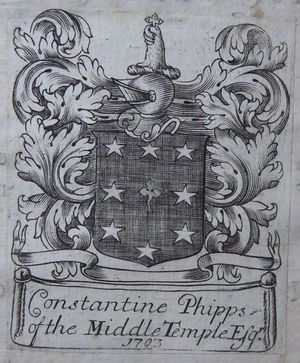Difference between revisions of "Constantine Phipps 1656-1723"
| Line 11: | Line 11: | ||
<div id="sourcelist"> | <div id="sourcelist"> | ||
*Alston, R. C., ''Inventory of sale catalogues ... 1676-1800'', St Philip, 2010. | *Alston, R. C., ''Inventory of sale catalogues ... 1676-1800'', St Philip, 2010. | ||
| + | *Gambier Howe, E. R. J. ''Franks bequest: catalogue of British and American book plates bequeathed to the ... British Museum''. London, 1903-4. | ||
*Hayton, D. W. [https://doi.org/10.1093/ref:odnb/22186 "Phipps, Sir Constantine (bap. 1656, d. 1723), lord chancellor of Ireland."] Oxford Dictionary of National Biography. | *Hayton, D. W. [https://doi.org/10.1093/ref:odnb/22186 "Phipps, Sir Constantine (bap. 1656, d. 1723), lord chancellor of Ireland."] Oxford Dictionary of National Biography. | ||
*[https://www.geni.com/people/William-Phipps/6000000002188385123 William Phipps, Geni]. | *[https://www.geni.com/people/William-Phipps/6000000002188385123 William Phipps, Geni]. | ||
Latest revision as of 08:31, 28 May 2023
Sir Constantine PHIPPS 1656-1723
Biographical Note
Son of Francis Phipps of Reading, publican. Financial stringencies limited his education, but he was admitted at the Middle Temple where he became a barrister in 1684. His legal career was patronised by the attorney-general, Sir Robert Sawyer, when Phipps married his niece Catherine Sawyer, and he developed a successful practice as an attorney, though his tory politics hampered his chances of advancement. He was made Lord Chancellor of Ireland in 1710, and knighted; he was much involved in Irish politics until the change of regime after Queen Anne's death led to his resignation and return to London legal practice, where he was active in supporting Jacobites and their cause.
Books
Phipps used an engraved armorial bookplate, dated 1703 (Franks 23550/*278). His son, William (ca.1698-1730) was also attached to the Middle Temple. After his death their combined libraries were auctioned in London, beginning 29 April 1730. No catalogue survives, but the sale was advertised in the Daily Journal and the Daily Post.
Sources
- Alston, R. C., Inventory of sale catalogues ... 1676-1800, St Philip, 2010.
- Gambier Howe, E. R. J. Franks bequest: catalogue of British and American book plates bequeathed to the ... British Museum. London, 1903-4.
- Hayton, D. W. "Phipps, Sir Constantine (bap. 1656, d. 1723), lord chancellor of Ireland." Oxford Dictionary of National Biography.
- William Phipps, Geni.
